The AMD Threadripper 2990WX 32-Core and 2950X 16-Core Review
by Dr. Ian Cutress on August 13, 2018 9:00 AM ESTHEDT Benchmarks: Encoding Tests
With the rise of streaming, vlogs, and video content as a whole, encoding and transcoding tests are becoming ever more important. Not only are more home users and gamers needing to convert video files into something more manageable, for streaming or archival purposes, but the servers that manage the output also manage around data and log files with compression and decompression. Our encoding tasks are focused around these important scenarios, with input from the community for the best implementation of real-world testing.
Handbrake 1.1.0: Streaming and Archival Video Transcoding
A popular open source tool, Handbrake is the anything-to-anything video conversion software that a number of people use as a reference point. The danger is always on version numbers and optimization, for example the latest versions of the software can take advantage of AVX-512 and OpenCL to accelerate certain types of transcoding and algorithms. The version we use here is a pure CPU play, with common transcoding variations.
We have split Handbrake up into several tests, using a Logitech C920 1080p60 native webcam recording (essentially a streamer recording), and convert them into two types of streaming formats and one for archival. The output settings used are:
- 720p60 at 6000 kbps constant bit rate, fast setting, high profile
- 1080p60 at 3500 kbps constant bit rate, faster setting, main profile
- 1080p60 HEVC at 3500 kbps variable bit rate, fast setting, main profile
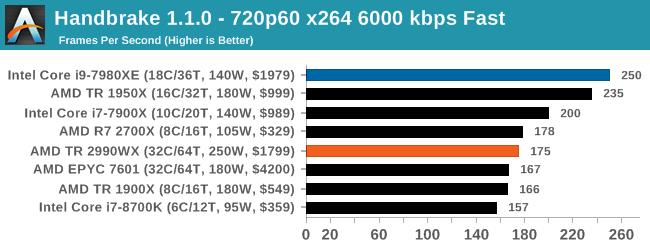
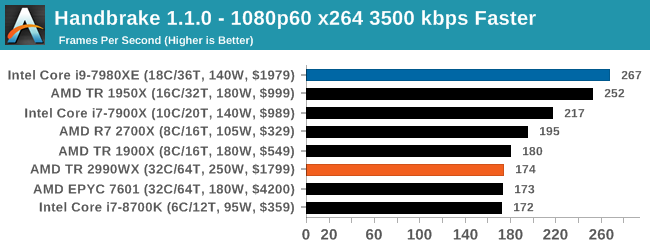
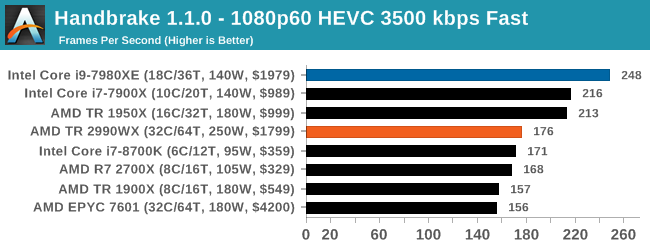
Video encoding is always an interesting mix of multi-threading, memory latency, and compute. The Core i9, with AVX2 instructions, sets a commanding lead in all three tests. The AMD processors seem to fluctuate a bit, with the 1950X and 2700X being the best of the bunch. Unfortunately we didn’t get 2950X results in our initial runs, but I would expect it to be competitive with the Core i9 for sure, given where the 1950X is. However the 2990WX does fall behind a bit.
7-zip v1805: Popular Open-Source Encoding Engine
Out of our compression/decompression tool tests, 7-zip is the most requested and comes with a built-in benchmark. For our test suite, we’ve pulled the latest version of the software and we run the benchmark from the command line, reporting the compression, decompression, and a combined score.
It is noted in this benchmark that the latest multi-die processors have very bi-modal performance between compression and decompression, performing well in one and badly in the other. There are also discussions around how the Windows Scheduler is implementing every thread. As we get more results, it will be interesting to see how this plays out.
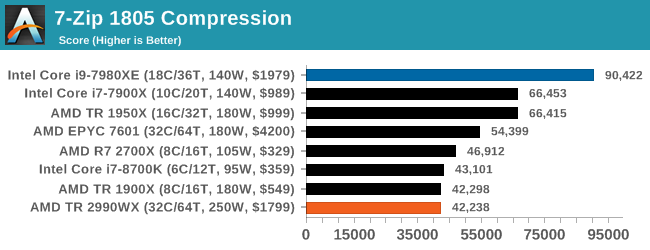
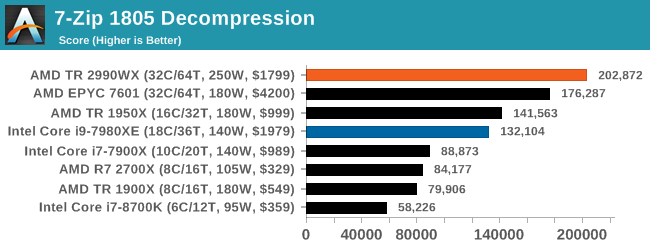
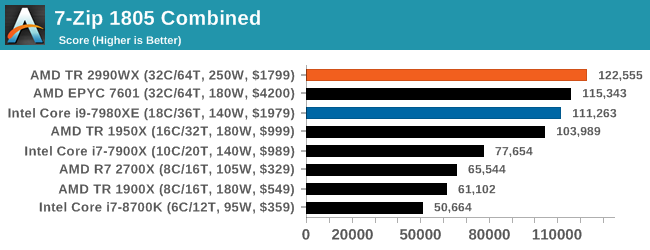
Oh boy, this was an interesting set of tests. When we initially published this review, without commentary, the compression graph with the 2990WX at the bottom was shared around social media like crazy, trying to paint a picture of why AMD performance isn’t great. It was also used in conjuction with Phoronix’s tests, that showed a much better picture on Linux.
But what confuses me is that almost no-one also posted the decompression graph. Here AMD’s 32-core processors take a commanding lead, with the 16/18-core parts being the best of the rest.
If you plan to share out the Compression graph, please include the Decompression one. Otherwise you’re only presenting half a picture.
WinRAR 5.60b3: Archiving Tool
My compression tool of choice is often WinRAR, having been one of the first tools a number of my generation used over two decades ago. The interface has not changed much, although the integration with Windows right click commands is always a plus. It has no in-built test, so we run a compression over a set directory containing over thirty 60-second video files and 2000 small web-based files at a normal compression rate.
WinRAR is variable threaded but also susceptible to caching, so in our test we run it 10 times and take the average of the last five, leaving the test purely for raw CPU compute performance.

A set of high frequency cores and good memory is usually beneficial, but sometimes some more memory bandwidth and lower latency helps. At the top is AMD’s R7 2700X, with the Intel 10-core just behind. I’m surprised not to see the 8700K in there, perhaps its six cores is not enough. But the higher core count AMD parts struggle to gain traction here, with the 32-core parts taking some sweet time to finish this test.
AES Encryption: File Security
A number of platforms, particularly mobile devices, are now offering encryption by default with file systems in order to protect the contents. Windows based devices have these options as well, often applied by BitLocker or third-party software. In our AES encryption test, we used the discontinued TrueCrypt for its built-in benchmark, which tests several encryption algorithms directly in memory.
The data we take for this test is the combined AES encrypt/decrypt performance, measured in gigabytes per second. The software does use AES commands for processors that offer hardware selection, however not AVX-512.
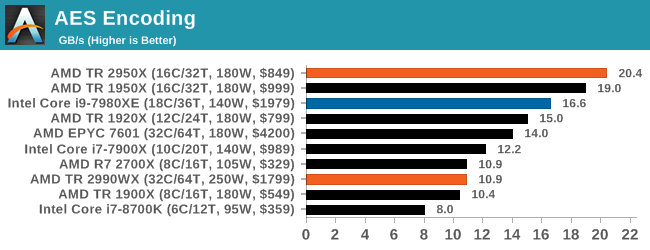
Normally we see this test go very well when there are plenty of cores, but it would seem that the bi-modal nature of the cores and memory controllers in the 2990WX gives a poor result. The EPYC 7601, with eight memory controllers, does a better job, however the 1950X wins here. The 2950X, where all cores have a similar access profile, scores top here, well above Intel’s 18-core Core i9.










171 Comments
View All Comments
Lolimaster - Monday, August 13, 2018 - link
I don't really see a point OCing the 2990WX, it seems quite efficient at stock setting with an average of 170w fully loaded, why go all the way to 400w+ for just 30% extra performance, it already destroys the 2950X/7980XE OCed to hell beyond repair.Lolimaster - Monday, August 13, 2018 - link
Threadripper 2990WX = Raid Bossyeeeeman - Monday, August 13, 2018 - link
Amazing performance from AMDs part. If you want to see a real review of 2990WX from a reviewer who understands how this CPU will be used, please check https://www.phoronix.com/scan.php?page=article&...mapesdhs - Monday, August 13, 2018 - link
Figured it would be those guys. 8) I talked to them way back when they started using C-ray for testing, after the original benchmark author handed it over to me for general public usage, though it's kinda spread all over the place since then. Yes, they did a good writeup. It's amusing when elsewhere one will see someone say something like, these CPUs are not best for gaming! Well, oh my, what a surprise, I could never have guessed. :DIn the future though, who knows. Fancy a full D-day simulator with thousands of players? 10 to 20 years from now, CPUs like this might be the norm.
eva02langley - Tuesday, August 14, 2018 - link
It is exactly what I said. If we don't have a proper test bed for a unique product like this, then the results we are going to provide are not going to be representative of the true potential of a CPU like this.Sites will need to update their benchmarks suites, or propose new review systems.
Gideon - Monday, August 13, 2018 - link
Great article overall. The Fabric Power part was the most interesting one! Though you might want to check The Stilt's comments regarding that:https://forums.anandtech.com/threads/2990wx-review...
and:
https://forums.anandtech.com/threads/2990wx-review...
Icehawk - Monday, August 13, 2018 - link
Ian, for in progress articles can they please be labelled that way? I would rather wait for the article to be complete than read just a few pages and have to check back hoping it has been updated.mapesdhs - Monday, August 13, 2018 - link
Ian, can you add C-ray to the multithreaded testing mix please? Becoming quite a popular test these days as it can scale to hundreds of threads. Just run at 8K res using the sphract scene file with a deep recursion depth (at least 8), to give a test that's complicated enough to last a decent amount of time and push out to main RAM a fair bit aswell.abufrejoval - Monday, August 13, 2018 - link
Ok, I understand it we are all enjoying this pay-back moment: Intel getting it on the nose for trying to starve AMD and Nvidia by putting chipsets and GPUs into surplus transistors from process shrinks, transistors that couldn’t do anything meaningful for Excel (thing is: Spreadsheets would actually be ideal for multi-cores even GPGPU, you just need to rewrite them completely…)But actually, this article does its best to prepare y’all for the worst: Twice the cores won’t be twice the value, not this time around, nor the next… or the one after that.
Please take a moment and consider the stark future ahead of us: From now on PCs will be worse than middle class smartphones with ten cores, where it’s cheaper to cut & paste more cores than to think of something useful.
KAlmquist - Monday, August 13, 2018 - link
I'm not sure AMD would have bothered with the 2990WX if it weren't for the Intel Core i9 7980XE. With 18 cores, the 7980XE beats the 16 core Threadripper 2950X pretty much across the board. On the other hand, if you running software that scales well across lots of cores--and you probably are if you're considering shelling out the money for a 7980XE--the 32 core 2990WX will be faster, for about $100 less.These are niche processors; I doubt either of them will sell in enough volume to make a significant difference to the bottom line at Intel or AMD. My guess is that both the 2990WX and the 7980XE were released more for the bragging rights than for the sales revenue they will produce.